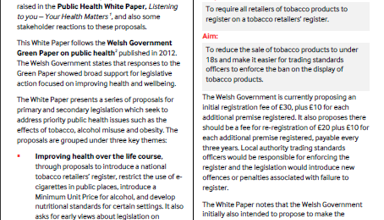Winter is always a busy time for health and social services, and there has been recent coverage of the pressures on these services, both in Wales and across the UK. Building on the work done during the Fourth Assembly, in Autumn 2016 the Health, Social Care and Sport Committee undertook an inquiry into how well prepared health and social care services in Wales were for winter 2016/17. A Plenary meeting of the Assembly’s on 1 February will be discussing the report on winter preparedness which was published by the Committee in December 2016.
Terms of reference for the inquiry
In seeking assurance that the Welsh NHS was equipped to deal with pressures on unscheduled care services during the coming winter, the Committee’s inquiry considered:
- the current pressures facing unscheduled care services, and how well prepared the Welsh NHS and social services were for winter 2016/17;
- whether there was sufficient progress in the Fourth Assembly in alleviating pressures on unscheduled care through integrated winter planning across health, social and ambulance services, and lessons learned; and
- the actions needed to produce sustainable improvements to urgent and emergency care services, and the whole system, ensuring the Welsh NHS builds resilience to seasonal demand and to improve the position for the future.
The terms of reference included a focus on patient flow (including primary care out of hours, emergency ambulance services, Accident and Emergency (A&E) departments, and delayed transfers of care from hospital).
Evidence gathering
The Committee consulted on this topic - the responses have been published – and held a number of sessions where it heard evidence from a range of professional bodies and stakeholder organisations including local health boards, social services and representatives of domiciliary and care home providers. A number of key themes emerged from the evidence the Committee received and heard:
- Service integration: there was scope for better joint planning and delivery of services between health and social care, and there was limited involvement of the independent sector;
- Demand: there are spikes in activity during the winter, but also significant and growing pressures all year round, driven especially by an ageing and frailer population – many of who have a number of complex needs. In addition, there are growing numbers of people with chronic conditions needing greater support from primary, community and hospital services. There was also evidence of increased numbers of children needing care for respiratory problems during the winter months;
- Service capacity: concerns about the capacity available to meet this demand across health and social care, with pressure points including primary and community care, hospital beds and increasing concerns about the domiciliary and care home sector;
- Workforce: difficulties in recruiting and retaining sufficient GP and hospital doctors, nurses and staff for domiciliary and care homes;
- Delayed discharges: there is still a need to ensure people are able to be discharged safely, promptly and with the right support in place when they no longer need hospital care;
- New models of care: there were calls for the development of new service models in primary and community care to avoid hospital admission, and different approaches to A&E services, potentially including primary care involvement and a possible role for ‘front-door’ physicians;
- Learning and reviewing: The Committee heard evidence of positive developments in a number of areas, including ambulance services and schemes supported by the Intermediate Care Fund (ICF). However, there was a clear emphasis on the need to ensure lessons of good practice were more widely shared and adopted. Evidence also suggested potential for improved working in some areas, including in the flu vaccine programme, where uptake amongst staff remained low and greater clarity was needed on working arrangements in primary care.
The Cabinet Secretary and Minister provided written evidence to the Committee highlighting details of plans being put in place to relieve pressure on unscheduled care services and to deal with the winter season. This highlighted that planning had been undertaken –starting earlier than in previous years - at national and local level, involving local health boards, social services, the Welsh Ambulance service and others. At the same time, the Cabinet Secretary acknowledged to the Committee that “I think we’re as well-prepared as we can be, but that does not mean that the system is in a perfect shape and there is not further improvement that we would expect to make”.
The Committee’s recommendations
The Committee’s report set out a number of conclusions and recommendations to the Cabinet Secretary for Health Wellbeing and Sport and the Minister:
- Securing greater integration of health and social care sectors should be a key priority for Welsh Government;
- Options should be explored for enabling more effective working arrangements between GPs and pharmacists in national preventative initiatives such as the flu vaccination;
- The Cabinet Secretary should ensure arrangements are in place to ensure that lessons learnt from effective services and Welsh Government-funded schemes are shared and learnt from;
- The Cabinet Secretary should report back to the Committee on what the additional £50 million invested has achieved;
- Research should be reviewed or commissioned into the effectiveness of primary care co-location in A&E departments;
- Publication of market analysis of domiciliary and care home services, to provide a clear picture of the capacity and resilience of the sector;
- Urgent consideration of the need for improved training, skills development and supervision across health and social care;
- There should be clarity about long term funding of successful schemes financed by the ICF, details made available of how 2017/18 ICF funding will be used and what the expected impact will be.
Article by Paul Worthington, National Assembly for Wales Research Service.






